For a few years, I lived on Rincon Hill in a Victorian hold-out amidst a bunch of warehouses and condo buildings on a charming tree-lined U-shaped street that was walking distance to all forms of local and regional public transport and was within easy loogie hawking distance of Highway 80. In fact, my street was smack in the armpit of that beast, and no matter which way I walked, in order to get anywhere at all except for the corner 76 station (you know, to stock up on petrol for my gas powered blender) or the deliciously local new Local, I had to circumvent the monstrosity itself or at least traverse one or two of its many feeders and bleeders.
In order to get to my nearest grocery store, I had to make my way across one multiple-lane highway on-ramp, one seedy highway underpass, one four-lane road, one six-lane boulevard, a couple of side streets, and a few high-traffic parking garage portals.
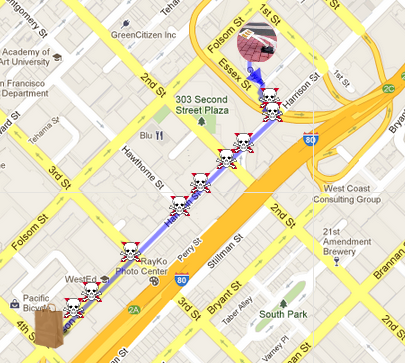
Whole Foods or Bust
Countless times, I’ve waited at the westbound walk signal at the corner of Harrison, a five-lane bidirectional street, and 3rd Street, a six-lane one-way boulevard, for permission to make my attempt to cross all six lanes without being mowed over by cars taking right turns at speed or getting pegged by left turners failing to take me into account while shooting for the pocket between on-coming cars.
As I knocked on the hoods or trunks of those cars that had gotten a little too fresh with me in my right of way, my mind often revisited the same line of questioning:
- Why in a forward-thinking “transit first” city like San Francisco can’t we designate just one fully-stocked section of town for those of us who don’t care to drive, park, or dodge private autos when going about our daily business?
- Why must I contend with this ridiculous life-and-death game of frogger just because I want to pick up a veggie platter for my dinner guests without first purchasing a car?
- And why must I pay taxes for the pleasure of having my nearest grocery store located half a mile away just to make room for all these multi-lane boulevards I will never use and am regularly abused by?
- Especially considering I have chosen to live right in the hub of all public transport for the entire region!
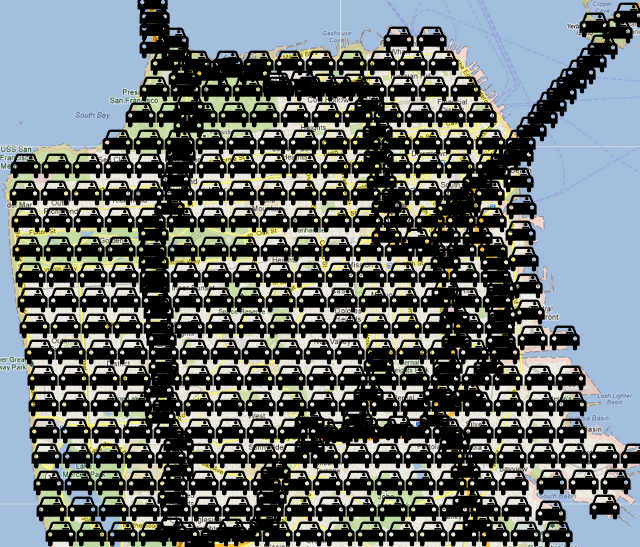
San Francisco’s under there somewhere
If given the option, it’s clear that plenty of people would choose to live in a place where getting groceries, going to school, commuting to work, collecting a visitor at the airport, picking up the dry cleaning, attending their kid’s soccer game, stopping by the pub, and going to a show were all easily doable without driving, parking, or being bossed around by cars. And wouldn’t this be a boon for San Francisco? Such a neighborhood wouldn’t take up much room, since nobody would need to store or drive a car, and it would attract residents and tourists, while requiring much less money per capita from the city for providing all of the required public utilities and services. Developers would likewise be free of the burden of providing parking for housing and businesses, driving building costs and sale prices down.
So what’s the hold up?
When you investigate the answers to this question, it’s extremely easy to get overwhelmed by a feeling of helplessness in the face of a lot of enduring systemic barriers to breaking down the auto-centric status quo:
- From the ludicrously car-biased traffic engineering standards
- To our mid-century-modern (but very un-Danish) minimum-parking requirements for new developments.
- Our ineffective transit funding strategies
- The city’s ongoing tendency to assign costs to MUNI’s budget that don’t belong there
- And MUNI’s continued mismanagement leading to even more hemorrhaging of funds.
But city officials these days are working hard on specific initiatives to address each of the above bullet points, giving us reason for optimism if we can just get past the biggest most elusive barrier of them all:
NIMBY-ism (No Impeding My Big Yukon)
The biggest problem alternative transportation advocates face in San Francisco is a city constituency subset that responds to rumors of change the same way my cat reacts whenever I mistakenly jostle the noisy door of her carrier while rummaging in the closet.

And straight under the bed she goes.
LOL Cat by Kevin Jarrett
There is, however, one neighborhood in San Francisco whose residents might not be so resistant to streetscape changes.
Chinatown: San Francisco’s Beacon of Hope
In Chinatown, car ownership is already at a mere 12%,[1] and the evidence suggests that the majority of its out-of-area patrons are also arriving without cars, yet its pedestrians are some of the most marginalized and put-upon in the city.[*]
The Grant Avenue Holy Grail
San Francisco urbanists have been noticing Chinatown’s potential for a while now. What warm-blooded pedestrian advocate could have failed to respond to the scene on Grant Avenue when it was opened up to pedestrians for two glorious Sunday afternoons of recreating, socializing, and shopping, as a part of San Francisco’s new Sunday Streets program? These events gave us a tantalizing window into what a car-free Chinatown might look like, all while giving local merchants concrete evidence that reducing car space can be good for business.[*]
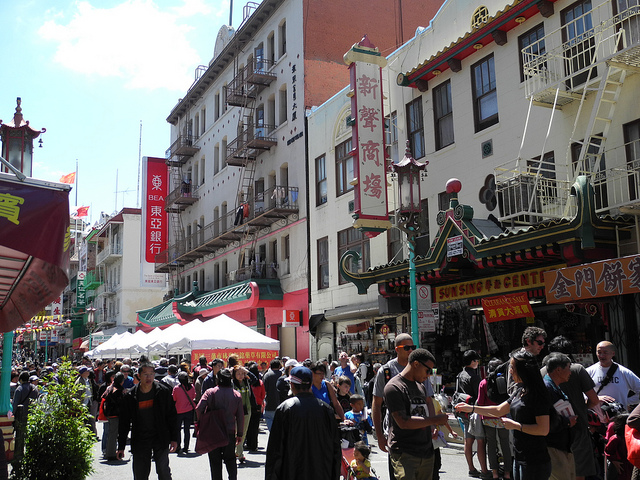
Grant Avenue Sunday Streets 2012
Photo by Dianne Yee
A car-free Grant Avenue is a compelling experience, to be sure, and many activists have been inspired to advocate for removing cars from this historic street as soon as possible.
But Stockton Street must be addressed before Grant Avenue
While I am ultimately all for pedestrianizing Grant Avenue, I think it is very important to address Stockton Street first for three reasons:
1. The problems on Stockton are worse
It’s more crowded
Chinatown is the densest neighborhood this side of Manhattan,[*] and nowhere is that more plainly evident than on the sidewalks of Stockton Street between Sacramento and Broadway during business hours, especially if you happen to be carrying a shopping bag or walking a bike. Heaven help you if you are in a wheelchair, behind a walker, or in front of a piece of rolling luggage. And if you thought it might be easier to push your child in a stroller to free up some hands for carrying a bag or two, I’m afraid you’re just going to have to cab it to Clement Street and try your plan there.
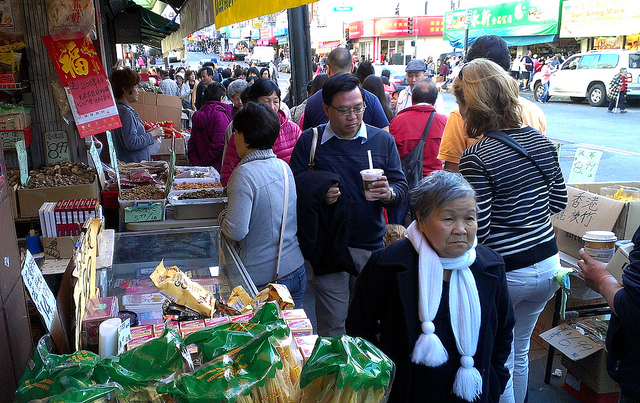
Excuse me. Pardon me. Coming through.
Trying to walk along Stockton even as an athletic and unencumbered young person can be extremely taxing, but it’s not because there’s not enough space. It’s because not enough of the available space is allocated to the people who live, work, play, shop, and go to school locally, because traffic engineers decided some decades ago that the vast majority of the space would be better utilized by outsiders who would like to drive their cars over Chinatown on their way from downtown to North Beach and beyond.
It’s more dangerous
Stockton Street also has a much higher pedestrian-vehicle collision rate than Grant Avenue does,[*] and it’s not hard to see why. Stockton Street has more lanes of traffic going at higher speeds, and there is considerably more pressure on pedestrians to step out into traffic lanes to get around crowds and other obstacles on the sidewalk.
2. Stockton Street is where the locals are
The safety problems and inequitable distribution of space on Stockton are especially poignant because Stockton happens to be where the majority of the locally-oriented shops are found, like grocery stores, printers, Chinese herb shops, clothing stores, acupuncture clinics, bric-a-brac stores, restaurants, butchers, and other stuff I totally don’t understand because I’m not even a little bit Chinese. This stands in obvious contrast to the calmer and roomier Grant Avenue, which is host to more of the tourist oriented shops, like high-end jewelers, novelty shops, and gift shops full of San Francisco schwag.
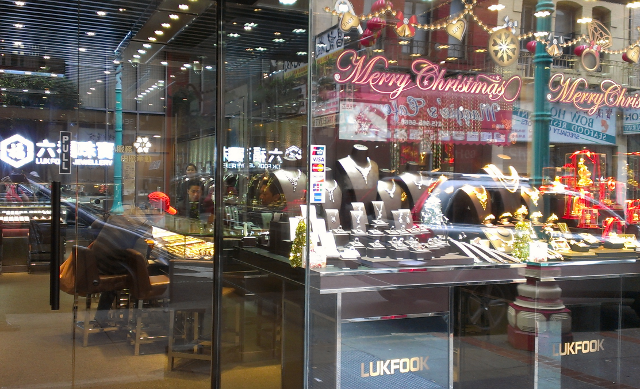
LukDonTouch
The median household income in Chinatown is $17,630,[1] so I’m pretty sure it’s not the locals who are hitting up Lukfook‘s new Grant Avenue location for their Holiday shopping needs.
3. The problems will be harder to solve if Grant is already car free
The Chinatown Community Development Center (CCDC) and the San Francisco Planning and Urban Research Association (SPUR) recently joined forces to help identify solutions to Stockton’s problems, and while they came up with some good recommendations, in my opinion they didn’t push the boundaries quite hard enough to come up with the best plan for Chinatown’s residents.
What’s needed along Stockton Street are comprehensive, sweeping changes in the allocation of space, which is of course going to meet with considerable political resistance, but imagine for a moment how much harder it would be if Grant Avenue were already shut down to car traffic.
Therefore I strongly believe that if we truly have Chinatown’s best interests in mind, we have to tackle the harder problems on Stockton Street first.
A plan of action for Chinatown, by me
Step Zero: Listen while I tell you a little story
I’ve been spending quite a lot of time in Chinatown recently, and in that time, I’ve detected four primary uses motorized vehicles make of Stockton Street:
- Parking
- Public transport
- Loading and unloading
- Just passing through
Nothing too surprising there, until you look a little more closely at the parking.
I had heard rumors from a couple different sources that most cars parked curbside in Chinatown are sporting handicap placards and are there all day every day. So I decided to check this out for myself.
In the morning and evening of December 4th and in the morning, evening, and late night on December 12th, I pounded the pavement all over Chinatown, recording the license plates of cars featuring handicap placards. What I found was absolutely in line with the rumors.
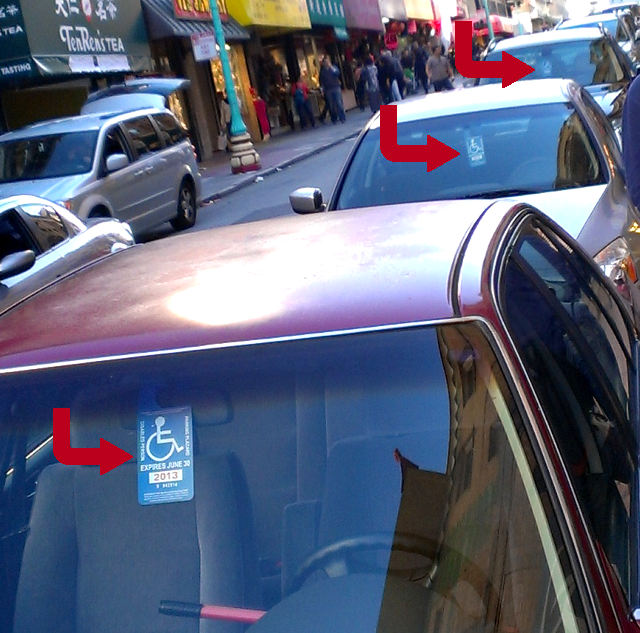
Hmmm
- The overwhelming majority of cars parked at ordinary meters during my daytime and evening visits were displaying handicap placards.
- At least 65% of the license plates I recorded on the morning of December 4th on Grant Avenue were also there (and usually in the same spot) during at least one of my subsequent visits.
- On the morning of December 12th, I made a point to arrive on the scene about half an hour to an hour before shops were open on Grant Avenue, and I watched as, one after another, people parked their handicapped-placarded cars in front of still-closed shops, exited their single-occupancy vehicles with hot coffees in hand and walked several blocks to wherever they were going. Eight hours later 50% of these cars had not moved an inch.
- There are fewer places to park on Stockton street that are not subject to daily 4-6pm street-cleaning closures but I found the general pattern there to be the same. Overall in Chinatown, 58% of the license plates I recorded during my first snapshot were also present during at least one subsequent snapshot.
- Almost all of the license plates I recorded during the daytime on the 12th were not present after 11pm.
- I stumbled on a further piece of anecdotal evidence around 7pm one night when I saw some people loading baking equipment from a bakery into a handicap-placarded car parked right outside the shop.
All of these findings strongly suggest that most of the cars which are taking up the prime curb-side parking spots in front of the shops in Chinatown do not belong to customers (who would not have remained in place for multiple data snapshots) or to residents (who would have residential permits and who would not all vacate the area by 11pm) or to genuinely handicapped people, but rather they very likely belong to shop owners or employees.
Step One: Implement parking reforms on Stockton and beyond
Historically, the SFMTA has tried to fight handicap placard abuse in the city generally by raising fees for violators and by discussing requiring handicap placard holders to pay the meters like everyone else. I think a much better answer for Chinatown is to incentivize shop owners to give up these spaces to customers arriving on foot, on transit, and by bike, in return for (1) forgiveness, (2) the inevitably increased business they’ll get, (3) some reserved loading zones, and (4) a guaranteed subsidized spot in one of the many nearby garages. If enough shop owners sign on to the plea bargain, there would also be plenty of space for new blue curbs to be painted at every cross street for the minority of present-day visitors and residents who are actually disabled and arriving by car.
We already know from experience that removing parking wholesale from Stockton street is a win for businesses and customers, as it was clearly demonstrated earlier this year when all parking was removed for one week. So really there is nothing to fear from dramatic parking reform in the area, so long as it is thoughtfully executed.
Thoughtful execution would also mean not opening up the newly-freed space on Stockton and Grant to other cars, as that would obviously be a very large step in the wrong direction. The current situation is extremely useful in that it is illustrative of the fact that those spaces in front of the shops are not contributing economically to the area, so it would be critical not to lose any time in giving the space back to the residents, visitors, and merchants of Chinatown in the form of bulb-outs, parklets, bike parking, or spaces for vendor stalls. And don’t worry, the community will have no trouble putting that space to use.
Step Two: Restrict Stockton to local traffic only
As far as the locals are concerned, Stockton’s most important function is to provide access to pedestrians, transit, and those vehicles which are actively loading and unloading inventory and passengers.
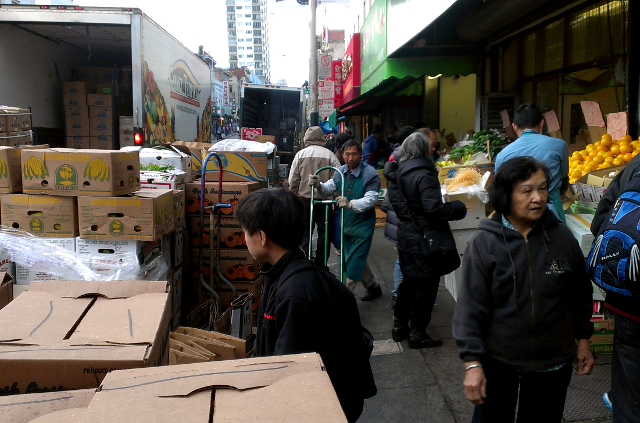
A usual weekday morning on Stockton Street
Stockton between Sacramento and Broadway should be reduced to one travel lane in each direction for buses, bikes, delivery vehicles, handicap-placarded cars, and otherwise-permitted cars with several turnouts on both sides for active loading and unloading. The resulting complementary pedestrian bulb-outs between loading areas would be eagerly gobbled up by shop owners and customers who can barely get an inventory display or a shopping bag in edgewise today. Crossing the street at intersections or even (gasp) mid-block would also be made dramatically safer by reducing the crossing distance significantly.
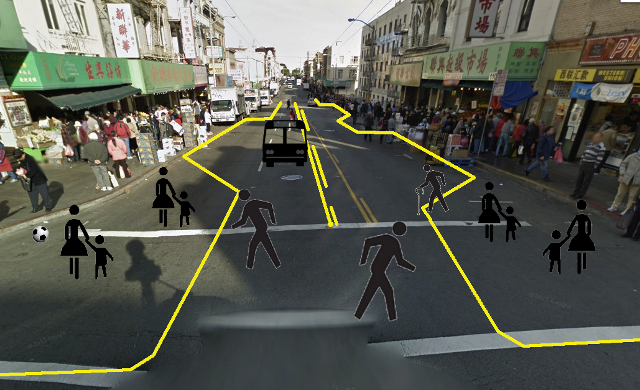
Only 12% of Chinatown residents own cars,[1] but 100% live with traffic-related air quality hazards
Removing the graded curbs at cross streets would make crossing easier and safer for pedestrians and would help make it clear that no non-local traffic should be turning onto this street from side streets.
From what I’ve been able to determine, this new configuration for Stockton Street would serve the local population quite well. And if done right, transit speed and capacity would also be greatly improved. Restricting loading activities during peak commute hours, for example, would go a long way toward moving buses through faster during the most critical times.
Step Three: Ignore complaints from non-locals. They will be OK.
Of course we can expect a lot of moaning from those people who currently use Stockton to drive cars from their downtown jobs to their favorite bars in North Beach, but by now it will surprise nobody to discover that I’m not at all concerned with their first-world problems. As we’ve seen, through traffic in a neighborhood like this one is a social justice issue. A very small fraction of Chinatown residents own cars but every last resident is subjected daily to the very real health hazards, safety problems, intimidations, and inconveniences created by throngs of outsiders who insist on making time with their cars straight through Chinatown’s kitchen in order to get a good seat at the strip club on the other side.
So for those non-locals who are left wondering how they will get their car from downtown to the Lusty Lady in time to see their favorite dancer take the stage, I have two words: “Go around.” Or even better, seven words, especially for the drinkers: “Take the bus. It’s way faster now.” Or eight for those able-bodied young people who could stand to lose a few pounds: “Just walk or bike. It’s fun, I promise.”
But seriously, by the laws of reduced demand, in a situation like this one, despite appearances, the long term negative impacts on neighboring streets of restricting motor vehicle access to Stockton is likely to be minimal. And at any rate, it is only fair that those citizens who are addicted to their cars make some baby steps toward keeping to themselves the externalities they generate.
Step Four: Close just one block of Grant Avenue
The major challenge of Chinatown is absolutely Stockton Street, but once it is returned to its rightful owners, Grant Avenue is the next obvious place to look for further optimizing the health, safety, beauty, and function of Chinatown. To start with, simply installing two cement bollards in the middle of the Chinatown gate and a couple of corresponding ones on the brink of Pine would go a long way.
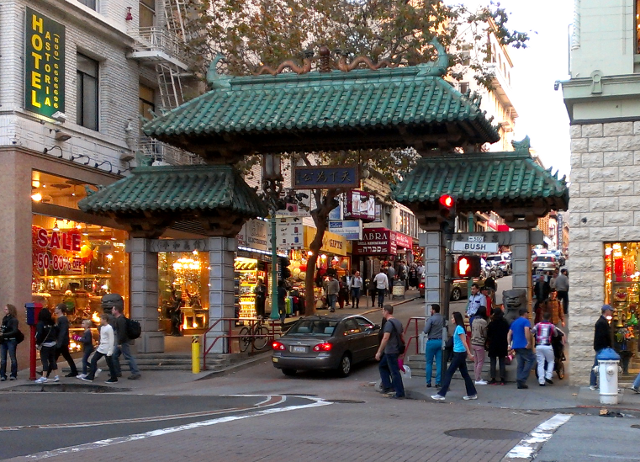
A great place for a couple of cement bollards if ever I saw one.
If Grant was no longer a useful through street, this already relatively calm street would become a lot more like the idyllic Waverly Place.
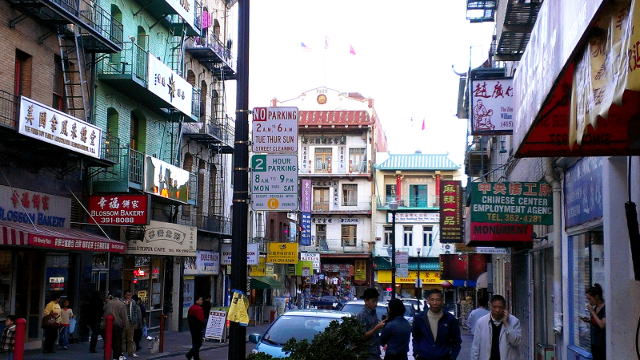
Waverly Place
On Waverly Place, the densest and most stunningly beautiful two block stretch in the entire neighborhood, you start to get a feel for the potential of Grant Avenue if it were to be made similarly inconvenient to through traffic.
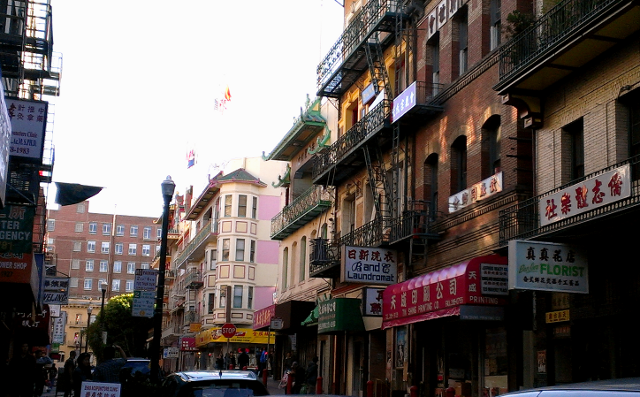
Waverly Place
This would be an easier sell than shutting the entire street to traffic, and the effects would be dramatic all along Grant Avenue and throughout the neighborhood.
For example, if even just one block were to be entirely pedestrianized, I like to think a night market like those found in Hong Kong and Taiwan might spring up in our very own Chinatown. Just imagine it for a second:
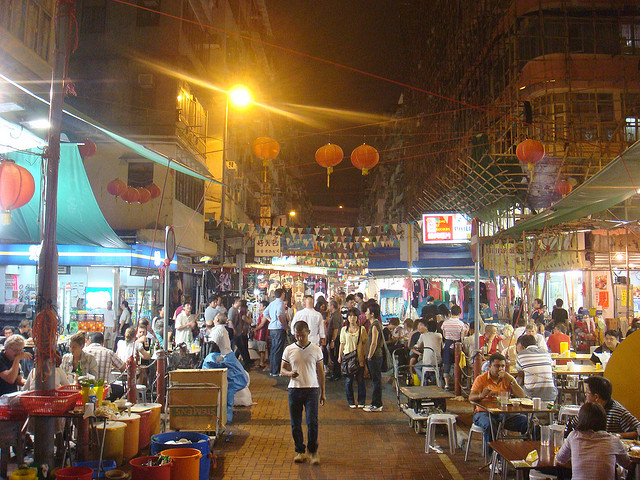
Temple Street Night Market in Hong Kong. Imagine this on Grant Avenue.
Photo by James Diggans
Step Five: Start accepting applications from North Beach for similar reforms
If Chinatown is allowed to begin reaching its potential as a relatively car free utopia in the middle of the city, residents in other neighborhoods may begin to recognize the purchasing power of the car space in their own pedestrian-heavy corridors. We can hope that successes in Chinatown will generate the jealousy and political will required to nice up other parts of the city. I would be gratified beyond words to see San Francisco lead the way in bringing a little bit of the charm of the world’s more livable cities to our own country.
[1] Chinatown statistics gathered from this document released by the San Francisco Planning Department after the 2010 census.
